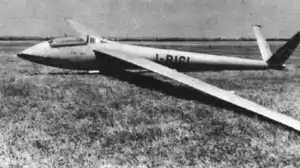| 3V-1 Eolo | |
|---|---|
 | |
| Role | High performance glider |
| National origin | Italy |
| Manufacturer | SIAI-Marchetti |
| Designer | Giovanni Bruni |
| First flight | August 1955 |
| Number built | 1 |
The Bruni 3V-1 Eolo was a single seat Italian competition glider, first flown in 1955. It took part World Gliding Championships of 1956 but retired early after sustaining damage.
Design and development
The Bruni 3V-1 Eolo, sometimes known as the SIAI-Marchetti Eolo 3V-1, was a high performance sailplane designed by Giovanni Bruni in Italy in the early 1950s. The 3V-1 was built by a collaboration between SIAI-Marchetti and the Alessandro Passeleva Soaring Sports Club of Vergiate. The high performance sailplane, intended for competitions and record breaking, was an all wooden cantilever mid-wing aircraft, with a high aspect ratio, single spar wing which was sharply tapered in plan and mounted with 3° of dihedral.[1][2] The wing was covered with unusually thick plywood to maintain the laminar profile[3] and its tips carried "salmons", small streamlined bodies intended to minimise induced drag. Narrow slotted control surfaces filled the whole trailing edge, each occupying about a third of the span; the outermost were conventional ailerons, followed by a second set of ailerons which drooped when the flaps on the inboard third of the wing were lowered.[1][2] The Eolo had a pair of mid-chord airbrakes mounted just behind the wing spar, each with sixteen blades deployed above and below the wing surfaces.[1] In the initial version there were inboard leading edge tanks that could hold 32 kg (71 lb) of water ballast.[1]
The Eolo's fuselage was a wood framed, ply skinned semi-monocoque of elliptical cross-section. Behind a pointed nose the pilot sat under a long, one piece canopy which extended rearwards almost to the wing leading edge where it was smoothly blended into the fuselage. It had a straight tapered V-tail with surfaces at 110°, ending in salmons, like the wings.[1] The elevators were equipped with trim tabs.[4] The glider had a monowheel undercarriage, equipped with a brake, which retracted behind two doors. There was also a sprung tailskid and a small protective nose skid.[1]
The Eolo first flew in August 1955.[1] A year later it competed in the World Gliding Championships held at Saint-Yan but had to retire after an accident on the third day.[5]
Specifications (3V-1 Eolo)
Data from The World's Sailplanes - Die Segelflugzeuge der Welt - Les Planeurs de le Monde (1958)[4]
General characteristics
- Capacity: One
- Length: 8.55 m (28 ft 1 in)
- Wingspan: 20.00 m (65 ft 7 in)
- Wing area: 16.00 m2 (172.2 sq ft)
- Aspect ratio: 25
- Airfoil: root : NACA 653618 ; tip : NACA 651612
- Empty weight: 329.5 kg (726 lb)
- 365 kg (805 lb) equipped
- Max takeoff weight: 450 kg (992 lb)
Performance
- Stall speed: 40 km/h (25 mph, 22 kn) with full flaps (50°)
- 60 km/h (37 mph; 32 kn) no flaps
- Never exceed speed: 230 km/h (140 mph, 120 kn)
- Airbrake limiting speed: 160 km/h (99 mph; 86 kn)
- Aerotow speed: 100–130 km/h (62–81 mph; 54–70 kn)
- Maximum glide ratio: 32.8:1 at 96.5 km/h (60.0 mph)
- Rate of sink: 0.79 m/s (156 ft/min) at 92 km/h (57 mph)
- Wing loading: 28.1 kg/m2 (5.8 lb/sq ft)
References
- 1 2 3 4 5 6 7 Taylor, John W R (1960). Jane's All the World's Aircraft 1960-61. London: Sampson Low, Marston & Co. Ltd. p. 191.
- 1 2 Pedrielli, Vincenzo; Camastra, Francesco (2011). Italian Vintage Sailplanes. Königswinter: EQIP Werbung & Verlag GmbH. pp. 224–5. ISBN 9783980883894.
- ↑ "Eolo 3 V1". Sailplane and Gliding. VII (4): 194. August 1956.
- 1 2 Wilkinson, K.G.; Brooks, Peter; Shenstone, B.S. (1958). The World's Sailplanes - Die Segelflugzeuge der Welt - Les Planeurs de le Monde (in English, German, and French). Vol. I. Organisation Scientifique et Technique International de Vol à Voile (OSTIV) & Schweizer Aero-Revue. pp. 146–9.
- ↑ "World Gliding". Flight. Vol. 70, no. 2478. 20 July 1956. pp. 122–3.
Further reading
- Bridgman, Leonard, ed. (1958). Jane's All the World's Aircraft 1958-59. London: Jane's All the World's Aircraft Publishing Co. Ltd. pp. 199–200.